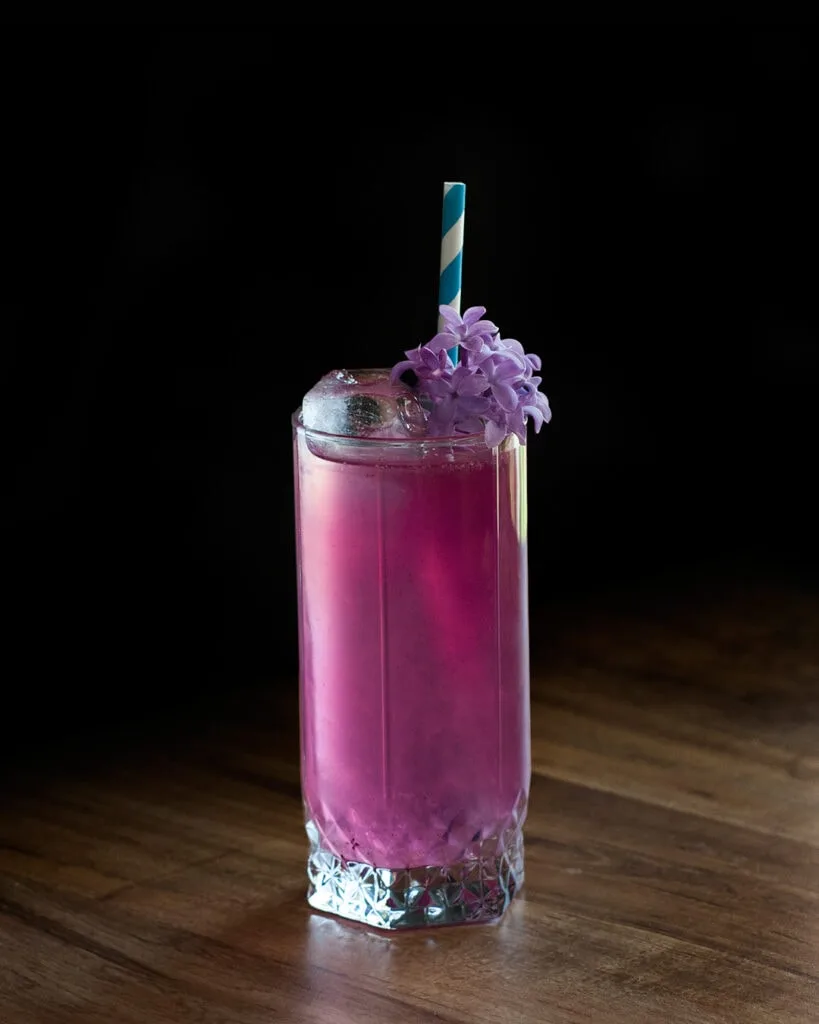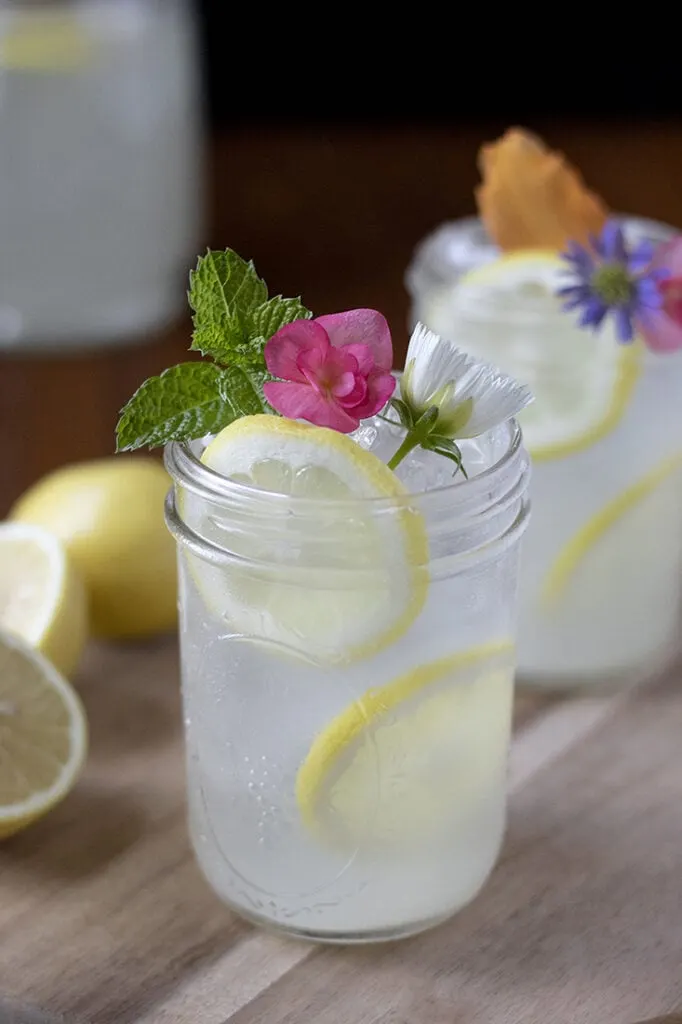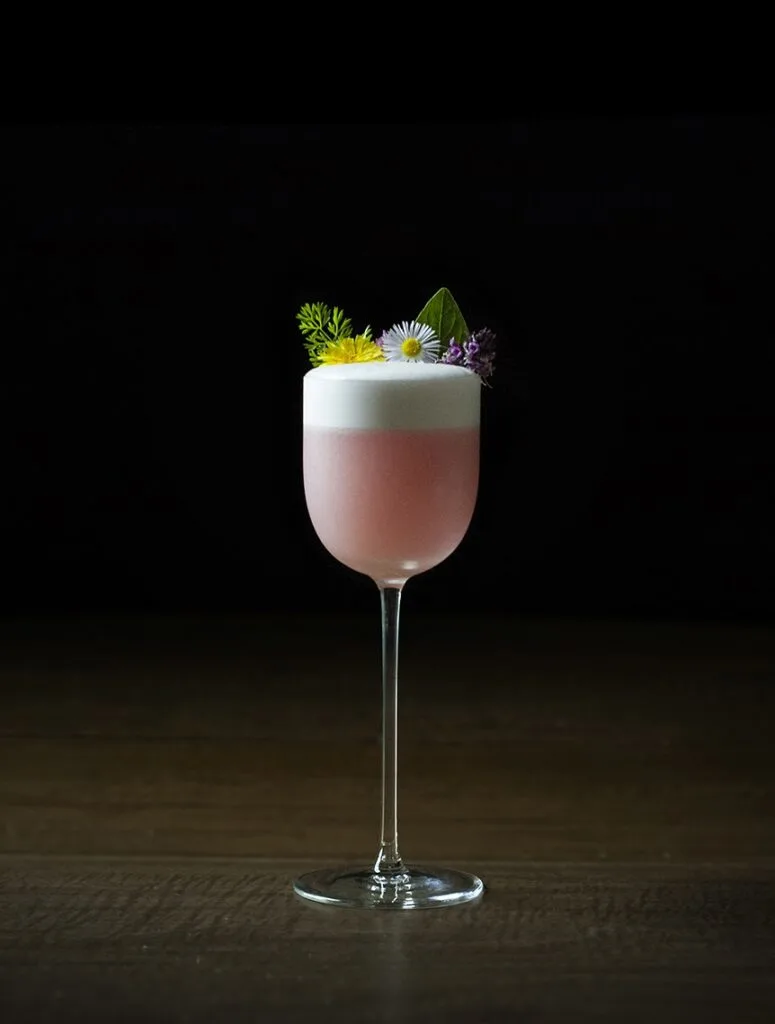Welcome to The Ultimate Guide to Cocktail Syrups: Part Three! In Part One, we covered the basics of simple syrups and storing them, in Part Two we started exploring flavored simple syrups made with fruits and herbs, like grenadine. Now we’re going to go even deeper, and explore more flavored cocktail syrups including: orgeat, spice syrups, syrups made from high quality extracts, and more advanced syrups like wine syrups, shrub syrups, and oxymels.
Disclosure: This post may contain Amazon affiliate links. This means that if you click through and make a purchase, I will earn a small commission at no extra cost to you.
Nuts, Spices, and Extracts: Other Specialty DIY Cocktail Syrups
Orgeat: the amazing almond syrup that brings tiki cocktails to life!
Orgeat is a creamy almond syrup that’s used in many classic tiki cocktails, including the Mai Tai. It’s also used in the simple classic cognac cocktail, the Japanese Cocktail. I love to use its beautifully rich, nutty and slightly floral flavor in a variety of cocktails, from the Tiki Margarita and the Scorpion to a spring brunch cocktail, Campari Rose, to the apple, lemon, and almond gin cocktail, Garden of Eden.
How to (easily) make orgeat at home
Ingredients:
- 2 cups of almonds, sliced or chopped
- 1 ½ cups sugar
- 1 ½ cups water
- 1 tsp orange flower water
- 2 oz vodka (or rum!)
Instructions: Toast the almonds at 400° for a few of minutes, then let cool. Put the nuts in a food processor or blender and pulverize, or place the nuts in a ziplock bag and crush them with a rolling pin. Now, combine the water and sugar in a saucepan over medium heat, stirring until the sugar dissolves. Then add the almonds and bring the mixture to a boil. Boil for about a minute, then remove from heat, cover, and let steep at least 2 hours, or up to overnight. Strain through a fine mesh strainer or multiple layers of cheesecloth. Stir in the orange flower water and vodka and store in a covered container in the refrigerator for 3+ weeks.

Spice Syrups
Spice syrups are an excellent way to add flavor to cocktails, and they’re just as simple to make as herb and tea syrups. The nice thing about spices is that a little goes a long way, so you don’t have to use a whole lot of a spice to achieve the flavor you’re looking for. Some spices that work beautifully in cocktail syrups are: vanilla, cinnamon, star anise, clove, cardamom, turmeric, and ginger. To make a simple syrup from a spice, simply add a small amount of the spice to equal parts sugar and water and heat in a saucepan for about 5 minutes. Remove the spice and syrup mix from the heat and let it cool fully. Once cool, strain out the spice and store in a covered container in the refrigerator.
Spice Syrup Guide
These spice ratio recommendations are based on batches of 1 cup sugar to 1 cup water, using the heat and steep method described above. Unless stated otherwise, the spices noted are whole (not ground). Some tasty cocktails using spice syrups are my Blood Orange Turmeric Collins, Pink Gin Saffron & Rose Lemonade, and Strawberry Vanilla Daiquiri.
- Allspice: 2 tbsp allspice berries
- Cinnamon: 4 sticks
- Cardamom: 5-8 green pods, lightly crushed
- Pink peppercorn: 1-2 tbsp
- Saffron: A pinch (about 15 threads)
- Star anise: 3-5 whole pods
- Clove: 2 tsp whole cloves
- Turmeric and Ginger: a few inches of peeled and chopped root
- Vanilla: 2 beans

Vanilla Syrup
Try this vanilla syrup in my Raspberry Passion Fruit Tequila Sour!
Ingredients:
- 1 cup sugar
- 1 cup water
- 2 vanilla beans, cut in half OR 1 tbsp quality pure vanilla extract
Instructions: If using vanilla beans, combine sugar and water in a saucepan and heat on low just until the sugar has dissolved. Add vanilla beans, bring to a boil, then reduce to low and simmer for 5 minutes, or until flavorful. Remove from heat and allow to cool before straining out the vanilla beans. Store in a covered container in the refrigerator.
If using vanilla extract, simply combine the water, sugar, and extract in a jar and stir until the sugar has dissolved. Store in a covered container in the refrigerator.
Cinnamon Syrup
Instructions:
- 1 cup sugar
- 1 cup water
- 4 cinnamon sticks
Instructions: Combine sugar and water in a saucepan and heat on low just long enough to dissolve the sugar. Add the cinnamon sticks, then remove from heat and allow to cool fully before removing cinnamon sticks. Store in a covered container in the refrigerator.
Extracts and Floral Waters in Cocktail Syrups
I discovered a fantastic, organic, high quality coconut extract on Amazon a while back, and it’s not only great for baking – it makes a delicious, natural-tasting coconut syrup! This coconut syrup recipe couldn’t be easier. Simply combine the sugar, water, and extract, and stir until the sugar has dissolved. Depending on the brand of coconut extract you use, you may want to adjust the quantity of extract used. Look for a high quality extract for the best, most natural-tasting flavor.

Easy Coconut Syrup
This is one of my very favorite, easy simple syrups to make for drinks. It’s also amazing on Belgian waffles with plenty of fresh strawberries! Just be sure to choose a quality coconut extract for the best flavor. Artificial coconut flavor won’t give you the same fresh, nutty taste that a pure extract will.
Try it in my Coconut Daiquiri or a slight variation in my Coconut Orange Blossom Margarita!
Get the full recipe and more ways to enjoy it in my Easy Coconut Simple Syrup Recipe
Ingredients:
- Sugar
- Water
- Quality coconut extract (I use Flavorganics Organic Coconut Extract)
Rosewater Syrup
Try my saffron-infused rosewater syrup recipe too!
Rosewater is the by-product from the extraction of steam-distilled rose essential oils. It’s essentially a potently scented water, and it makes for lovely (and easy) rose flavored syrup. Just like the coconut syrup above, this one is as easy as measure, stir, store. Want another easy and really delicious cocktail syrup? Try combining these two recipes, using half coconut extract, half rosewater! I also love to combine coconut with orange blossom water.
Ingredients:
- 1 cup sugar
- 1 cup water
- 1 tbsp rosewater (more or less, to taste)
Instructions: Stir all ingredients until the sugar has dissolved. Store in a covered container in the refrigerator.
Next Level Cocktail Syrups
Wine Syrups
If you’ve ever had to dump a half-drunk bottle of wine down the drain because it went bad before you could finish it, this is a syrup to try! You can make wine syrups from red, white, rose, and even sparkling wines. The fruitier the wine, the better. Wine syrups are one of the easiest cocktail syrups to make, but they add an incredible depth of flavor. Simply combine 1 part wine with 1 part sugar and heat on low, just until the sugar has dissolved. Remove from the heat, let cool, and store in a covered container in the refrigerator.
Advanced Floral Syrups
If you’re into edible flowers or floral flavors, you can make cocktail syrups from flowers too! You can make cocktail syrups from fresh or dried edible flowers (like lavender and chamomile, see under Herbal Syrups). Learn all about the different kinds of edible flowers in my Guide to Edible Flowers. Or check out my recipes for foraged Forsythia Honey Syrup and Lilac Liqueur.

Oleo Saccharum
Don’t be intimidated by the name, this syrup is incredibly basic, and a must-have tool in any home bartender’s cocktail syrup arsenal! Oleo saccharums are syrups produced from the natural oils of citrus fruits. The name says it all: oleo (oil) saccharum (sugar). By tossing equal parts (by weight) orange, lemon, lime, or grapefruit peels and sugar, the oils are extracted, creating a rich, intensely flavored syrup. Hand toss the peel and sugar mix to ensure that each peel’s skin is thoroughly coated, then give them a firm press with a muddler to help express the oils. After the mixture sits for a while (an hour, or longer), you’ll be left with the most incredible citrus syrup you’ve ever tasted.

Keep in mind that this syrup will be much sweeter than simple syrup because it’s just sugar with a relatively small amount of oil. As a result, you can choose to add water to the syrup to make it a bit easier to measure and mix with, or just strain out the peels and use it as is. Pure oleo saccharum is usually just used by the barspoon or quarter ounce because of its intensity and sweetness.
Create the oleo saccharum syrup by peeling your citrus with a vegetable peeler or a sharp paring knife and tossing them with an equal measure of sugar (by weight) in a mixing bowl. Cover and let sit for a couple of hours. You’ll know it’s done when nearly all of the sugar has dissolved and you’re left with a beautiful pool of citrusy oil-syrup in the bottom of the bowl. Strain out the peels and store the syrup in a covered container in the refrigerator.
You can find a lemon oleo saccharum tutorial with photos in my recipe for The Best Lemonade Ever. My lemonade recipe does dilute the oleo saccharum with water to make measuring easy, so you can skip that if you want pure, unadulterated oleo.
Shrub Syrups
Shrub syrups are a delicious sweet and sour syrup made by combining fruit (or herbs), sugar, and vinegar. In addition to being a great sweet and acidic cocktail ingredient, shrub syrups simply mixed with sparkling water make incredibly refreshing homemade sodas. Try a watermelon, strawberry, and basil shrub syrup in the summertime! When it comes to the vinegar component, I recommend starting with apple cider vinegar and experimenting from there. Apple cider vinegar pairs well with many fruits. White vinegar is a bit too sharp in my opinion, but I have made some tasty shrubs with champagne vinegar.
Cold Method Shrub Syrup
I recommend using the traditional cold shrub syrup method, which is a little time consuming, but totally worth it. Fortunately, it’s not a lot of work, just a bit of waiting. If you’re impatient (which I usually am too), you can combine the ingredients in a saucepan and heat just until the fruit begins to break down. However, you’ll really be missing out on the fresh, vibrant flavor that comes from allowing the sugar to slowly work its magic. Also, heating vinegar will make your kitchen smell pretty funky, FYI.
A shrub syrup combines equal parts fruit, sugar, and vinegar. Begin by tossing your (washed and roughly cut or chopped) fruit with the sugar. Cover and let this mixture sit undisturbed for at least a few hours, and up to 24 hours. I recommend placing the mixture in the refrigerator while you wait. Then strain out the fruit and combine the resulting fruity syrup (as well as any undissolved sugar) with the vinegar. Stir the vinegar syrup mixture well to dissolve any remaining sugar crystals and store in a covered container in the refrigerator. Shrub syrups will last for quite a while in the fridge thanks to the vinegar.

Oxymels
The final syrup recipe I want to share is one that’s probably the least well known to cocktail lovers (and most folks, really). Oxymels are an ancient syrup that combine honey with vinegar (as well as fruits or herbs). Often used as a kind of medicine, oxymels are a great way to make herbal infusions. Personally, I like to use them to add floral sweetness and acidity to my cocktails. I wrote about oxymels in my Guide to Edible Flowers:
“Oxymels are a delicious way to preserve the flavors of summer and create herbal or floral infusions to use in cocktails, salad dressings, as herbal medicine, or diluted with sparkling water like a shrub. An oxymel, meaning ‘acid + honey’, is just that – a mixture of equal parts honey and vinegar. I like to use local wildflower honey and organic apple cider vinegar. You can combine both ingredients in a jar, shake it well, and enjoy as is, or you can add herbs or other botanicals and let it sit for a few weeks to make an infusion.”
Cocktail Syrup Flavor Pairing Ideas
Now that we’ve discussed all of the different kinds of cocktail syrups, here’s some great flavor pairing ideas for your next homemade craft cocktail! For blending fruits and herbs in simple syrups, you can use the ratios I’ve recommended above and in Part Two as a starting point. For example, if I was making a strawberry and lavender syrup, I would use: 1 cup water, 1 cup sugar, 1-2 cups strawberries and about 3 tbsp dried lavender buds.

Consider how each botanical handles heat when deciding on the syrup method to use. You can also heat one component first, and then just use the long steep method from Part Two when you add the herbs. So for strawberry and lavender syrup, I would heat the strawberries on the stove top in the simple syrup for 5 minutes, or until the fruit just starts to break down. Then I’d stir in the lavender buds, remove from the heat, and let the syrup completely cool, covered, before straining.
You could also use the fresh fruit syrup method from Part Two, then add the lavender buds and let the syrup steep in the refrigerator overnight before straining the lavender. Experiment and see what gives you the flavors you like best! Here are some of my favorite flavor combinations for cocktail syrups:
- Strawberry and lavender
- Blueberry and basil
- Coconut and rose (using quality extract and rosewater)
- Vanilla and rose (using quality extract and rosewater)
- Pineapple and star anise
- Orange peel and mint
- Ginger and honey
- Cardamom and pear
- Hibiscus and raspberry
- Watermelon and basil
I hope you’ve enjoyed Part Three of my Ultimate Guide to Cocktail Syrups! You can find Part One here and Part Two here.
Are there any other syrups you want to learn more about? Comment below and I’ll do my best to update this post regularly with fresh information.
And as always, if you make any of these cocktail syrups, remember to share it on Instagram and tag me @moodymixologist!


